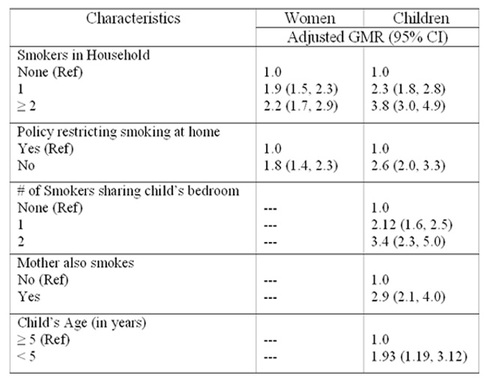ASHES, 4(8) – No smoking (at home) please
|
In an international effort to educate people about the dangers of Second Hand Smoke (SHS), 168 nations participate in the World Health Organization Framework Convention on Tobacco Control (WHOFCTC). Article 8 of this convention asks that participating nations, “in areas of existing national jurisdiction” put operational measures in place to protect citizens from SHS in “indoor workplaces, public transport, indoor public places, and as appropriate, other public places”(World Health Organization, 2003). However, home exposure to SHS is equally hazardous to health. Wipfli et al. examine the effect of SHS exposure by measuring the home air nicotine exposure and hair nicotine levels of women and children from 31 developing countries (Wipfli et al., 2008).
Methodology:
- Participants:
- Women and children from 1284 households in 31 countries on 3 continents (Approximately 40 households per country)
- Data Collection:
- A four section survey: (1) personal/socioeconomic characteristics; (2) smoking history; (3) SHS exposure; (4) viewpoints about dangers of smoking tobacco-control policies
- Passive air monitors measured air nicotine concentrations from main family room during a 7 day period
- Collected 30-50 strands from rear of the scalp from 1 child (≤11 years) and primary female caregiver from each household
- Laboratory Analysis:
- Air nicotine: gas chromatography1
- Hair nicotine: gas chromatography1 and mass spectrometry2 (capillary column)
Result(s) of interest:
- The data in the Figure suggest that the nicotine concentration in both women and children increases twofold if smoking is permitted in the
home. - 82% of smokers admitted to smoking around their children.
- Median hair nicotine concentration was higher in children (0.68ng/mg) than in women (0.40ng/mg).

Figure. Adjusted Geometric Mean Ratios (GMRs) of Hair Nicotine Concentrations among Women and Children* Click image to enlarge.
*Adapted from Geometric Means (GMs) and Geometric Mean Ratios (GMRs)
or Hair Nicotine Concentrations Among Women and Children Living in
Households Exposed to Secondhand Smoke, by Household Characteristics:
International Survey, 2006. (Wipfli et al., 2008)
*Median Hair Concentrations were skewed, log-10 transformed, and run through multilevel linear models.
Limitations:
- Investigators did not select households randomly and the number of households per country was limited, therefore the sample might not be representative of the households in each country.
- Continuous air nicotine measurements mean that the final reported concentrations of nicotine could be lower than actual exposure concentrations
- 60% of women had chemically treated hair, which could decrease measured nicotine concentration (Al-Delaimy, 2002; Pichini, Altieri, Pellgrini, Pacifici, & Zuccaro, 1997)
Discussion:
More than three quarters of participants admit to smoking around their children. Differences in the uptake and metabolism of nicotine in children, compared to women, leads to an obvious difference in reported hair nicotine concentrations: children evidence greater concentrations than women. Despite the WHO attempt to restrict SHS Exposure in public places, the initiative needs to expand to include messages warning about SHS in the home. A lack of focus on SHS in the home suggests that public bans will be insufficient to decrease the health risks associated with SHS. An increase in advertising, more legislative bans on public smoking, education about SHS dangers, and clinical discussion about the dangers of smoking are a good place to start expanding the initiative.
–Ingrid R. Maurice
Notes
1. Separating a substance into its components by diffusing it, along with a carrier gas, through a liquid or solid absorbent.
2. Determining the masses of atoms or molecules by placing an electrical
charge on the molecule and analyzing that mass/charge ratio of the
resulting ions.
References
Al-Delaimy, W. (2002). Hair as a biomarker for Exposure to Tobacco Smoke. Tobacco Control, 11, 176-182.
Pichini, S., Altieri, I., Pellgrini, M., Pacifici, R., & Zuccaro, P. (1997). Hair Analysis for Nicotine and Cotinine: Evaluation of Extraction Procedures, Hair Treatments, and Development of Reference Material. Forensic Science International, 87(1-3), 243-252.
Wipfli, H., Avila-Tang, E., Navas-Acien, A., Kim, S., Onicescu, G., Yuan, J., et al. (2008). Secondhand Smoke Exposure Among Women and Children: Evidence from 31 Countries. American Journal of Public Health, 98(4), 672-679.
World Health Organization. (2003). Framework Convention on Tobacco Control. Article 8: Protection from Exposure to Tobacco Smoke Retrieved July 21, 2008, 2008, from http://www.who.int/tobacco/framework/WHO_FCTC_english.pdf
What do you think? Please use the comment link below to provide feedback on this article.